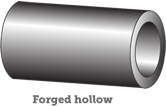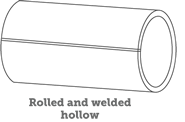What are the benefits of a seamless hollow-core forging?
- Share
- Issue Time
- Mar 7,2019
What are the benefits, with respect to residual stresses, of a seamless hollow-core forging over rolled and welded plate that is subsequently processed (machining, heat treating, etc.)?
In general, distortion of a component will occur when the stress states of either the individual components or the assembly as a whole shift from one state of equilibrium to a new equilibrium state. The presence of residual stresses in the components act as a source of potential energy similar in nature to a spring fixed in a compressed state. If the fixture holding the spring remains intact, the spring does not expand. However, once the fixture is removed, the spring expands until it reaches a new state of equilibrium—either another fixed point or a point where the potential energy of the spring is expended—and the spring is extended. So, too, will the potential energy in a component due to residual stress remain unchanged until the equilibrium state is altered—either through mechanical means (metal removal or cold/warm straightening, etc.) or thermal means (welding, heat treatment, etc.).
 Using this model, it is apparent that the key to minimizing distortion is to select a fabrication process that (1) uses input material with little or no residual stress and (2) will permit a subsequent processing path that introduces as little residual stress as possible. To form a plate into a cylinder, in most cases, it will require stretching the metal beyond its yield point to both hold the cylindrical shape and allow for the subsequent spring-back. If it is assumed that the starting plate is essentially free of residual stress due to processing at elevated temperatures (a large assumption, indeed), the equilibrium state of the plate is subsequently changed during rolling through the introduction of tensile and compressive stresses that shift the equilibrium state to that of a cylindrical shape (requiring a weld to hold it in place because of the tendency to spring back, in particular with materials having a high yield strength).
Using this model, it is apparent that the key to minimizing distortion is to select a fabrication process that (1) uses input material with little or no residual stress and (2) will permit a subsequent processing path that introduces as little residual stress as possible. To form a plate into a cylinder, in most cases, it will require stretching the metal beyond its yield point to both hold the cylindrical shape and allow for the subsequent spring-back. If it is assumed that the starting plate is essentially free of residual stress due to processing at elevated temperatures (a large assumption, indeed), the equilibrium state of the plate is subsequently changed during rolling through the introduction of tensile and compressive stresses that shift the equilibrium state to that of a cylindrical shape (requiring a weld to hold it in place because of the tendency to spring back, in particular with materials having a high yield strength).
 Understanding the proportional relationship between stress and strain (elastic modulus), it can be intuitively understood that the stretching will spring back to a new state that now has residual stress present. In addition, the introduction of the longitudinal weldment to complete the cylindrical shape further disrupts the system through the introduction of thermal energy. The severity of the residual stress will increase with increases in either, or all, of the yield strength of the base metal, circumference of the tube and plate thickness. Once the desired shape is achieved, it will remain in that shape as long as no subsequent processing or service conditions that alters the stress state is performed (machining or welding, for example). When the part does distort, additional mechanical work is required to revive the desired shape, resulting in an often "circular" manufacturing path. These costs are often not considered when selecting a rolled and welded cylinder.
Understanding the proportional relationship between stress and strain (elastic modulus), it can be intuitively understood that the stretching will spring back to a new state that now has residual stress present. In addition, the introduction of the longitudinal weldment to complete the cylindrical shape further disrupts the system through the introduction of thermal energy. The severity of the residual stress will increase with increases in either, or all, of the yield strength of the base metal, circumference of the tube and plate thickness. Once the desired shape is achieved, it will remain in that shape as long as no subsequent processing or service conditions that alters the stress state is performed (machining or welding, for example). When the part does distort, additional mechanical work is required to revive the desired shape, resulting in an often "circular" manufacturing path. These costs are often not considered when selecting a rolled and welded cylinder.
Consider, now, a seamless hollow-core forging that is forged at elevated temperatures with dynamic recrystallization (the immediate formation of stress-free grains upon deformation). The stresses introduced during forging to produce the cylindrical shape are immediately removed through the recrystallization of the crystal structure, resulting in an essentially stress-free forging. Consequently, a rolled and welded assembly possesses significantly higher residual stress than a forged seamless cylinder (hollow-core). Furthermore, no thermal stresses from welding are introduced during formation of the cylinder as a seamless forged hollow-core, unlike the rolled and welded plate method. To summarize, the seamless hollow-core forging is far more stable and possesses a higher degree of structural integrity (no welds!) than a rolled and welded cylinder assembly for an often lower overall cost.